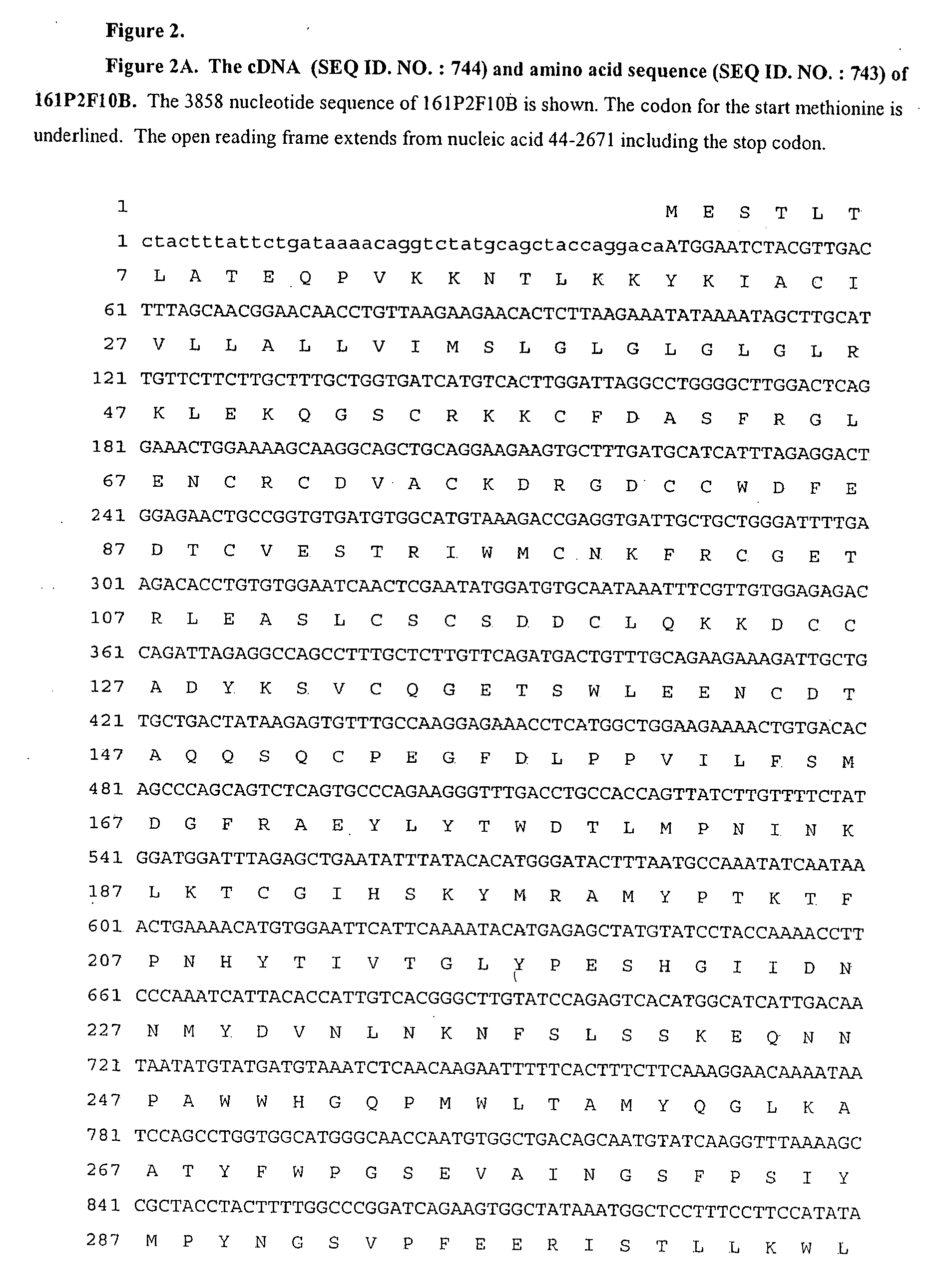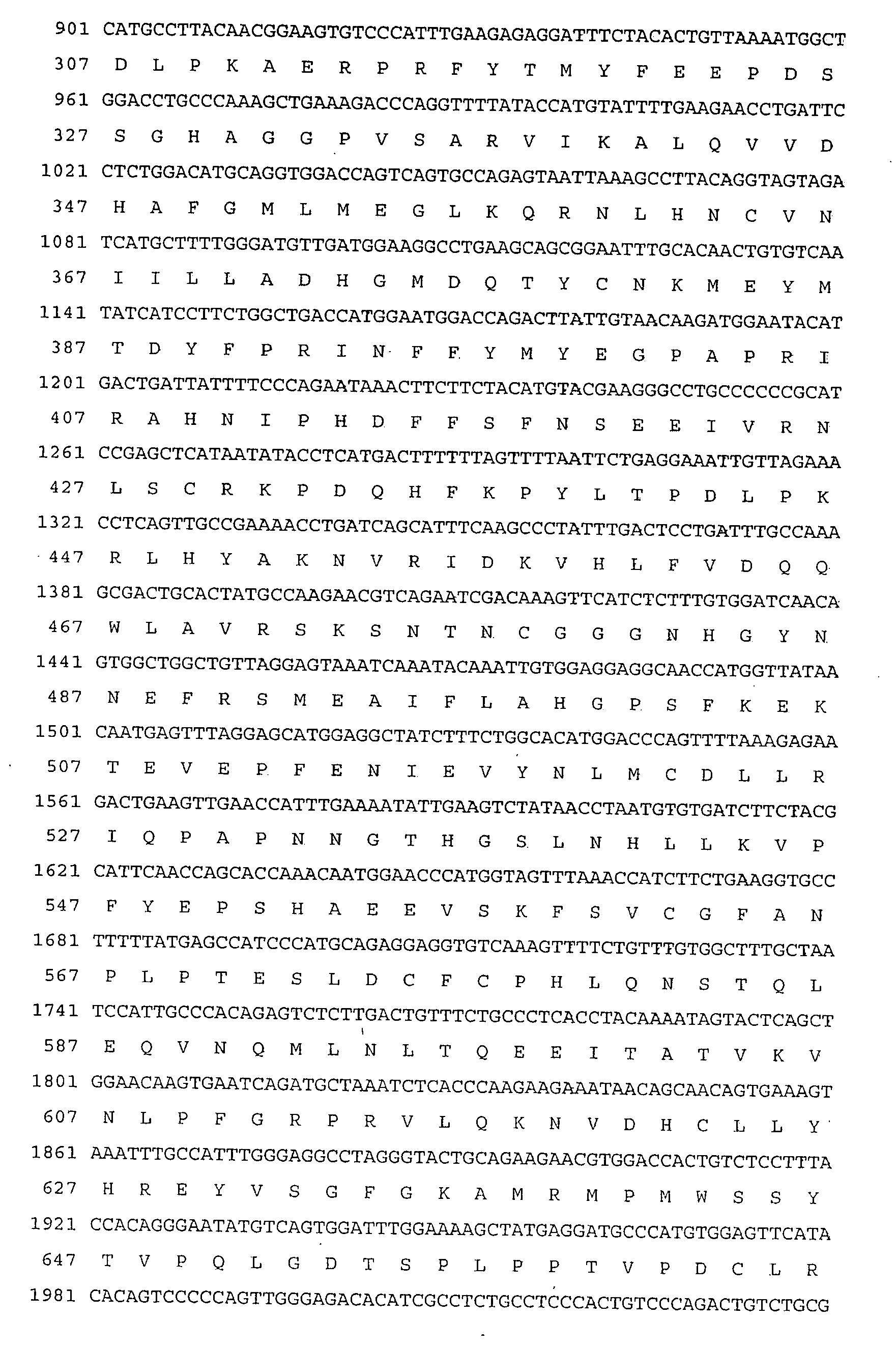Nucleic acid and corresponding protein entitled 161P2F10B useful in treatment and detection of cancer
a technology of nucleic acid and corresponding protein, which is applied in the direction of drug composition, peptide, tissue culture, etc., can solve the problems of ineffective treatment for many patients, inability to effectively treat metastatic prostate cancer, and undesirable consequences, so as to inhibit the effect of inhibiting the transcription, translation, processing or function
- Summary
- Abstract
- Description
- Claims
- Application Information
AI Technical Summary
Problems solved by technology
Method used
Image
Examples
example 1
SSH-Generated Isolation of a cDNA Fragment of the 161P2F10B Gene
[0404] To isolate genes that are over-expressed in kidney cancer we used the Suppression Subtractive Hybridization (SSH) procedure using cDNA derived from kidney cancer patient tissues.
[0405] The 161P2F10B SSH cDNA sequence was derived from a subtraction consisting of a kidney cancer minus normal kidney and a mixture of 9 normal tissues: stomach, skeletal muscle, lung, brain, liver, kidney, pancreas, small intestine and heart. By RT-PCR, the 161P2F10B cDNA was identified as highly expressed in kidney cancer pool, with lower expression detected in prostate cancer xenograft pool, prostate cancer pool, colon cancer pool, lung cancer pool, ovary cancer pool, breast cancer pool, metastasis cancer pool, pancreas cancer pool, 2 different prostate cancer metastasis to lymph node, VP1 and VP2. (FIG. 10).
[0406] The 161P2F10B SSH cDNA sequence of 182 bp matches the cDNA for phosphodiesterase I / nucleotide pyrophosphatase 3 (PDNP...
example 2
Full Length Cloning of 161P2F10B
[0430] To isolate genes that are involved in kidney cancer, an experiment was conducted using kidney cancer patient specimens. The gene 161P2F10B was derived from a subtraction consisting of kidney cancer specimens, minus normal kidney mixed with a cocktail of 9 normal tissues: stomach, skeletal muscle, lung, brain, liver, kidney, pancreas, small intestine and heart. The SSH DNA sequence (FIG. 1) was designated 161P2F10B. cDNA clone 161P2F10B was cloned from kidney cancer specimens (FIG. 2 and FIG. 3). 161P2F10B showed homology to the gene ENPP3. The amino acid alignment of 161P2F10B with ENPP3 is shown in FIG. 4 (also, see, e.g., Buhring, et al., Blood 97:3303-3305 (2001)).
[0431] 161P2F10B variant 1 was identified with a single base pair variation at nucleotide position 408 with a G instead of an A when compared to the published ENPP3 sequence (FIG. 2B, FIG. 3B). This nucleotide variation coded for amino acid Lysine in variant 1, compared to amino ...
example 3
Chromosomal Localization of 161P2F10B
[0432] Chromosomal localization can implicate genes in disease pathogenesis. Several chromosome mapping approaches are available including fluorescent in situ hybridization (FISH), human / hamster radiation hybrid (RH) panels (Walter et al., 1994; Nature Genetics 7:22; Research Genetics, Huntsville Ala.), human-rodent somatic cell hybrid panels such as is available from the Coriell Institute (Camden, N.J.), and genomic viewers utilizing BLAST homologies to sequenced and mapped genomic clones (NCBI, Bethesda, Md.).
[0433] 161P2F10B maps to chromosome 6q22, using 161P2F10B sequence and the NCBI BLAST tool.
PUM
| Property | Measurement | Unit |
|---|---|---|
| pH | aaaaa | aaaaa |
| concentration | aaaaa | aaaaa |
Abstract
Description
Claims
Application Information
 Login to View More
Login to View More - R&D
- Intellectual Property
- Life Sciences
- Materials
- Tech Scout
- Unparalleled Data Quality
- Higher Quality Content
- 60% Fewer Hallucinations
Browse by: Latest US Patents, China's latest patents, Technical Efficacy Thesaurus, Application Domain, Technology Topic, Popular Technical Reports.
© 2025 PatSnap. All rights reserved.Legal|Privacy policy|Modern Slavery Act Transparency Statement|Sitemap|About US| Contact US: help@patsnap.com



